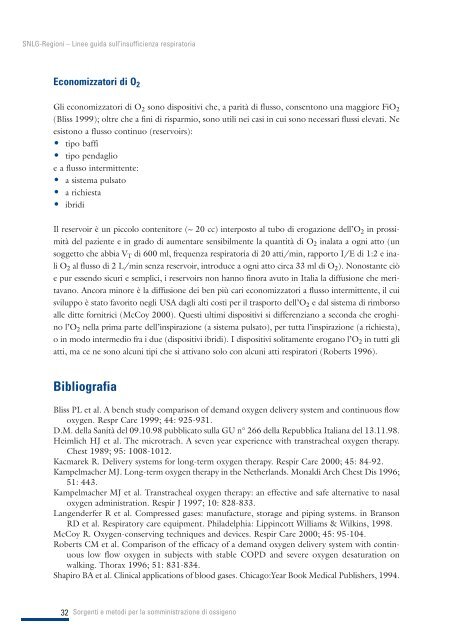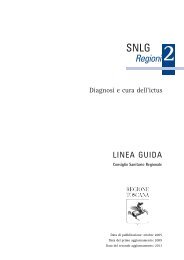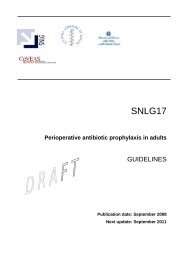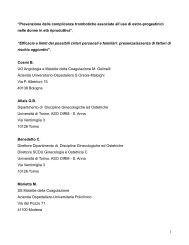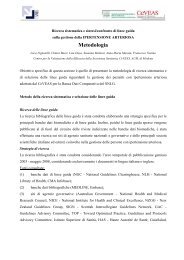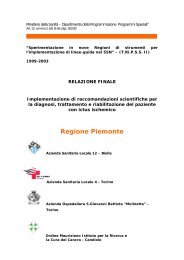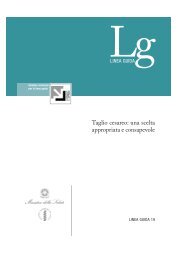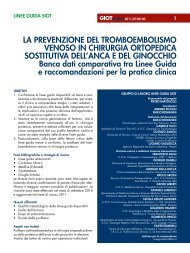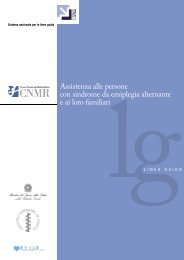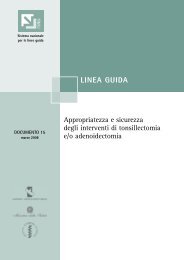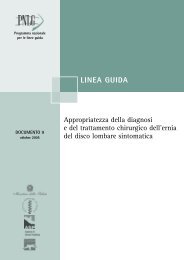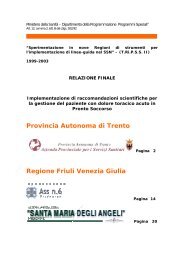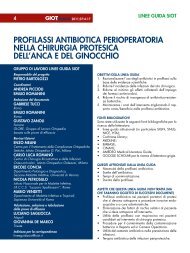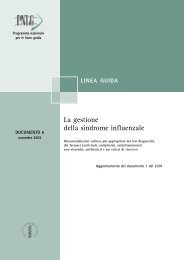Linee guida sull'insufficienza respiratoria - SNLG-ISS
Linee guida sull'insufficienza respiratoria - SNLG-ISS
Linee guida sull'insufficienza respiratoria - SNLG-ISS
You also want an ePaper? Increase the reach of your titles
YUMPU automatically turns print PDFs into web optimized ePapers that Google loves.
<strong>SNLG</strong>-Regioni – <strong>Linee</strong> <strong>guida</strong> sull’insufficienza <strong>respiratoria</strong><br />
Economizzatori di O 2<br />
Gli economizzatori di O 2 sono dispositivi che, a parità di flusso, consentono una maggiore FiO 2<br />
(Bliss 1999); oltre che a fini di risparmio, sono utili nei casi in cui sono necessari flussi elevati. Ne<br />
esistono a flusso continuo (reservoirs):<br />
• tipo baffi<br />
• tipo pendaglio<br />
e a flusso intermittente:<br />
• a sistema pulsato<br />
• a richiesta<br />
• ibridi<br />
Il reservoir è un piccolo contenitore (∼ 20 cc) interposto al tubo di erogazione dell’O 2 in prossimità<br />
del paziente e in grado di aumentare sensibilmente la quantità di O 2 inalata a ogni atto (un<br />
soggetto che abbia V T di 600 ml, frequenza <strong>respiratoria</strong> di 20 atti/min, rapporto I/E di 1:2 e inali<br />
O 2 al flusso di 2 L/min senza reservoir, introduce a ogni atto circa 33 ml di O 2 ). Nonostante ciò<br />
epuressendosicuriesemplici,ireservoirsnonhannofinoraavutoinItalialadiffusionechemeritavano.<br />
Ancora minore è la diffusione dei ben più cari economizzatori a flusso intermittente, il cui<br />
sviluppo è stato favorito negli USA dagli alti costi per il trasporto dell’O 2 edalsistemadirimborso<br />
alle ditte fornitrici (McCoy 2000). Questi ultimi dispositivi si differenziano a seconda che eroghino<br />
l’O 2 nella prima parte dell’inspirazione (a sistema pulsato), per tutta l’inspirazione (a richiesta),<br />
oinmodointermediofraidue(dispositiviibridi).Idispositivisolitamenteeroganol’O 2 in tutti gli<br />
atti, ma ce ne sono alcuni tipi che si attivano solo con alcuni atti respiratori (Roberts 1996).<br />
Bibliografia<br />
Bliss PL et al. A bench study comparison of demand oxygen delivery system and continuous flow<br />
oxygen. Respr Care 1999; 44: 925-931.<br />
D.M. della Sanità del 09.10.98 pubblicato sulla GU n° 266 della Repubblica Italiana del 13.11.98.<br />
Heimlich HJ et al. The microtrach. A seven year experience with transtracheal oxygen therapy.<br />
Chest 1989; 95: 1008-1012.<br />
Kacmarek R. Delivery systems for long-term oxygen therapy. Respir Care 2000; 45: 84-92.<br />
Kampelmacher MJ. Long-term oxygen therapy in the Netherlands. Monaldi Arch Chest Dis 1996;<br />
51: 443.<br />
Kampelmacher MJ et al. Transtracheal oxygen therapy: an effective and safe alternative to nasal<br />
oxygen administration. Respir J 1997; 10: 828-833.<br />
Langenderfer R et al. Compressed gases: manufacture, storage and piping systems. in Branson<br />
RD et al. Respiratory care equipment. Philadelphia: Lippincott Williams & Wilkins, 1998.<br />
McCoy R. Oxygen-conserving techniques and devices. Respir Care 2000; 45: 95-104.<br />
Roberts CM et al. Comparison of the efficacy of a demand oxygen delivery system with continuous<br />
low flow oxygen in subjects with stable COPD and severe oxygen desaturation on<br />
walking. Thorax 1996; 51: 831-834.<br />
Shapiro BA et al. Clinical applications of blood gases. Chicago:Year Book Medical Publishers, 1994.<br />
32 Sorgenti e metodi per la somministrazione di ossigeno


